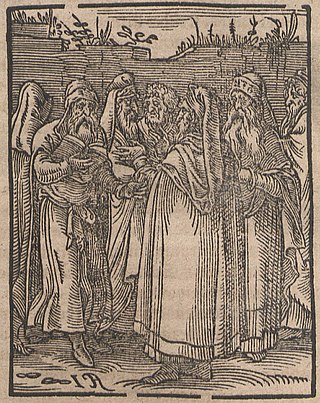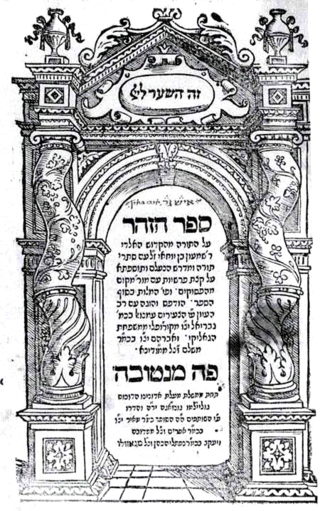Related Research Articles

A goddess is a female deity. In many known cultures, goddesses are often linked with literal or metaphorical pregnancy or imagined feminine roles associated with how women and girls are perceived or expected to behave. This includes themes of spinning, weaving, beauty, love, sexuality, motherhood, domesticity, creativity, and fertility. Many major goddesses are also associated with magic, war, strategy, hunting, farming, wisdom, fate, earth, sky, power, laws, justice, and more. Some themes, such as discord or disease, which are considered negative within their cultural contexts also are found associated with some goddesses. There are as many differently described and understood goddesses as there are male, shapeshifting, or neuter gods.

Kabbalah or Qabalah is an esoteric method, discipline and school of thought in Jewish mysticism. A traditional Kabbalist is called a Mekubbal. The definition of Kabbalah varies according to the tradition and aims of those following it, from its origin in medieval Judaism to its later adaptations in Western esotericism. Jewish Kabbalah is a set of esoteric teachings meant to explain the relationship between the unchanging, eternal God—the mysterious Ein Sof —and the mortal, finite universe. It forms the foundation of mystical religious interpretations within Judaism.

Lilith, also spelled Lilit, Lilitu, or Lilis, is a feminine figure in Mesopotamian and Jewish mythology, theorized to be the first wife of Adam and a primordial she-demon. Lilith is cited as having been "banished" from the Garden of Eden for not complying with and obeying Adam.

A succubus is a female-looking demon or supernatural entity in folklores who appears in dreams to seduce men, usually through sexual activity. According to religious tradition, a succubus needs semen to survive; repeated sexual activity with a succubus will result in a bond being formed between the succubus and the man; and a succubus will drain or harm the man with whom she is having intercourse. In modern representations, a succubus is often depicted as a beautiful seductress or enchantress, rather than as demonic or frightening.

The Zohar is a foundational work of Kabbalistic literature. It is a group of books including commentary on the mystical aspects of the Torah and scriptural interpretations as well as material on mysticism, mythical cosmogony, and mystical psychology. The Zohar contains discussions of the nature of God, the origin and structure of the universe, the nature of souls, redemption, the relationship of ego to darkness and "true self" to "the light of God".
Shekhinah is the English transliteration of a Hebrew word meaning "dwelling" or "settling" and denotes the presence of God in a place. This concept is found in Judaism and the Torah, as mentioned in Exodus 25:8.

Samael is an archangel in Talmudic and post-Talmudic lore; a figure who is the accuser or adversary, seducer, and Destroying angel.

Isaac ben Solomon Luria Ashkenazi, commonly known in Jewish religious circles as Ha'ari, Ha'ari Hakadosh or Arizal, was a leading rabbi and Jewish mystic in the community of Safed in the Galilee region of Ottoman Syria, now Israel. He is considered the father of contemporary Kabbalah, his teachings being referred to as Lurianic Kabbalah.

Shedim are spirits or demons in the Tanakh and Jewish mythology. Shedim do not, however, correspond exactly to the modern conception of demons as evil entities as originated in Christianity. While evil spirits were thought to be the cause of maladies, shedim differed conceptually from evil spirits. Shedim were not considered as evil demigods, but the gods of foreigners, and were envisaged as evil only in the sense that they were not God.
Lilith is a character in Jewish mythology.
In the Zohar, Lurianic Kabbalah, and Hermetic Qabalah, the qlippoth, are the representation of evil or impure spiritual forces in Jewish mysticism, the opposites of the Sefirot. The realm of evil is called Sitra Achra in Kabbalistic texts.
Hayyim ben Joseph Vital was a rabbi in Safed and the foremost disciple of Isaac Luria. He recorded much of his master's teachings. After Vital's death, his writings began to spread and led to a "powerful impact on various circles throughout the Jewish world."
Naamah or Nahemoth is a demon described in the Zohar, a foundational work of Jewish mysticism. She originated from and is often conflated with another Naamah, sister to Tubal-cain.

Eve is a figure in the Book of Genesis in the Hebrew Bible. According to the origin story of the Abrahamic religions, she was the first woman. Eve is known also as Adam's wife.
Agrat bat Mahlat is a demon in Jewish mythology.
Lurianic Kabbalah is a school of Kabbalah named after Isaac Luria (1534–1572), the Jewish rabbi who developed it. Lurianic Kabbalah gave a seminal new account of Kabbalistic thought that its followers synthesised with, and read into, the earlier Kabbalah of the Zohar that had disseminated in Medieval circles.
Yehuda Fetaya was a leading Kabbalist and authored many works of Kabbalah, among which three are well known, Yayin haReqa`h, Bet Le`hem Yehuda and Min`hat Yehuda.
Sefer HaTemunah is a 13–14th century kabbalistic text. It is quoted in many sources on Halakha.
Partzufim or Partsufim, meaning "Divine Personas", are particular reconfigured arrangements of the ten sefirot, divine attributes/emanations of Kabbalah. Each partzuf is thus a configuration of disparate entities into a harmonious unit. The names of the partzufim are derived from the Zohar, the foundational text of Kabbalah. There, they are synonymous terms for the sefirot. Their full doctrinal significance emerged in 16th century Lurianic Kabbalah with reference to the cosmic processes of Tohu and Tikun, "Chaos and Rectification".

Lilith, a biblical character suggested to be Adam's first wife and a significant female figure from Jewish mythology, has been developed over time into distinct characters in popular culture. One writer on witches, Judika Illes, wrote, "No spirit exerts more fascination over media and popular culture than Lilith. Her appearances are genuinely too numerous to count." Lilith is one of several figures with biblical or related origins integrated into popular culture who have been titled demon.
References
- ↑ Isaac Jack Lévy, Rosemary Lévy Zumwalt Ritual Medical Lore of Sephardic Women: Sweetening the Spirits Page 189 2002 "Also, on certain other nights of the week, which are the fixed time for this procedure, because in them many Liliths and demons are abroad, and go up and down" (Patai 1964, 4; quoting Sithon)."
- ↑ According to commentaries found in the Zohar volume 5 (the sifri Di Tsri-nita section of) the Pritzker edition translated by Daniel C. Matt pages 572-573, 578-579
- ↑ (pages 147-148,157-158 of the book: Window of the Soul: The Teachings of Rabbi Isaac Luria edited by James David Dunn; Lilith: a Rereading of Feminine Shadow by Ohad Ezrachi and Marc Gafni found on the website:kabalove.org/articles/Lilith-2nd-gate.